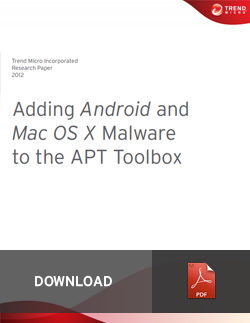Android, Mac OS X Malware Join Other Targeted Attack Tools
 Download the full research paper: Adding Android and Mac OS X Malware to the APT Toolbox
Download the full research paper: Adding Android and Mac OS X Malware to the APT Toolbox
APTs refer to cyber-espionage campaigns—a series of failed and successful attempts to compromise specific targets’ networks over time. APTs aim to establish persistent, covert presence in a target’s network in order to extract information as necessary.
While socially engineered emails designed to lure a target to execute malicious attachments are often used as an initial attack vector, those behind APT campaigns make use of a variety of “second-stage” malware downloads, usually Remote Access Trojans (RATs), and seek to acquire credentials that enable them to maintain presence (e.g., legitimate VPN access) without using malware.
APT attacks continue to adapt to the changing network landscapes of their targets. Earlier this year, Trend Micro documented the operation of a campaign known as “Luckycat,” which used a variety of malicious software to compromise their targets’ networks. They also used a variety of second-stage malware, which gave them an additional foothold in compromised networks.
During a recent investigation of a Luckycat C&C server, we found malware for the Android, Mac OS X, and Windows platforms. The malware for the Mac OS X platform known as “SabPub” was previously discovered and linked to the Luckycat campaign. SabPub was delivered both via malicious Word documents that exploit CVE-2009-0563 and a Java vulnerability, CVE-2012-0507.5 On this Luckycat C&C server, we found that SabPub is still being distributed via a Java exploit.
Like it? Add this infographic to your site:
1. Click on the box below. 2. Press Ctrl+A to select all. 3. Press Ctrl+C to copy. 4. Paste the code into your page (Ctrl+V).
Image will appear the same size as you see above.
Recent Posts
- Unveiling AI Agent Vulnerabilities Part I: Introduction to AI Agent Vulnerabilities
- The Ever-Evolving Threat of the Russian-Speaking Cybercriminal Underground
- From Registries to Private Networks: Threat Scenarios Putting Organizations in Jeopardy
- Trend 2025 Cyber Risk Report
- The Future of Social Engineering
 Cellular IoT Vulnerabilities: Another Door to Cellular Networks
Cellular IoT Vulnerabilities: Another Door to Cellular Networks AI in the Crosshairs: Understanding and Detecting Attacks on AWS AI Services with Trend Vision One™
AI in the Crosshairs: Understanding and Detecting Attacks on AWS AI Services with Trend Vision One™ Trend 2025 Cyber Risk Report
Trend 2025 Cyber Risk Report CES 2025: A Comprehensive Look at AI Digital Assistants and Their Security Risks
CES 2025: A Comprehensive Look at AI Digital Assistants and Their Security Risks